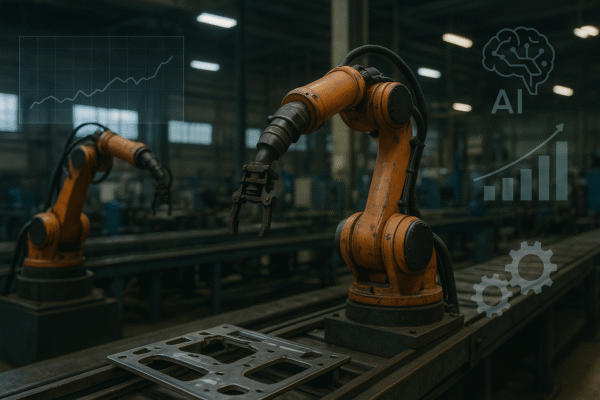
Data and AI in Manufacturing are transforming how manufacturers operate by enabling smarter decisions, improving efficiency, and cutting costs. By harnessing real-time analytics and artificial intelligence, manufacturers can streamline workflows, increase productivity, and gain a competitive edge. This article explores how data and AI in manufacturing play a crucial role in optimizing operations and provides practical strategies for success.
The Role of Data and AI in Manufacturing
Modern manufacturing operations generate massive volumes of data from equipment, production lines, inventory systems, and supply chains. However, without strategic analysis, this data remains underutilized. Data and AI in manufacturing allow businesses to extract actionable insights, enabling predictive and prescriptive decision-making.
A data-driven approach helps manufacturers detect inefficiencies, optimize scheduling, enhance product quality, and reduce downtime. With AI, they can transition from reactive problem-solving to proactive optimization.
Developing a Data-Driven Manufacturing Strategy
To fully capitalize on the power of data and AI in manufacturing, businesses need a strategy aligned with their operational goals. Key steps include:
1. Identifying Key Performance Indicators (KPIs)
Clear KPIs help focus data efforts on strategic objectives. Essential KPIs include:
-
Overall Equipment Effectiveness (OEE)
-
Production cycle times
-
Defect rates and product quality
-
Inventory turnover
-
Supply chain efficiency
-
Energy usage
These metrics provide benchmarks for evaluating performance and measuring improvements enabled by data and AI.
2. Integrating Data Across Systems
Siloed data limits the effectiveness of analytics. Manufacturers should adopt centralized data platforms using cloud-based solutions, ERP systems, and industrial IoT (IIoT) devices. These tools help consolidate data and enable cross-functional visibility.
By integrating systems, can support informed decisions across production, maintenance, logistics, and finance.
3. Leveraging Advanced Analytics and AI
Once data is centralized, manufacturers can apply AI and machine learning to derive deeper insights. Key applications include:
-
Predictive Maintenance: AI forecasts equipment failure before it happens.
-
Process Optimization: Machine learning uncovers production inefficiencies.
-
Supply Chain Optimization: Data and AI predict demand and manage inventory.
-
Quality Control: AI-powered inspections identify defects in real-time.
-
Energy Efficiency: AI reduces energy waste through intelligent usage tracking.
These use cases demonstrate how data and AI in manufacturing drive automation, accuracy, and agility.
Overcoming Challenges in Manufacturing Data Utilization
While the benefits of data and AI in manufacturing are clear, challenges persist:
-
Data Silos: Fragmented data limits holistic visibility.
-
Integration Issues: Legacy systems may lack compatibility with AI tools.
-
Data Quality: Inaccurate data undermines trust in insights.
-
Skills Gap: Expertise in both manufacturing and AI is scarce.
-
Cybersecurity Risks: Increased digitization heightens vulnerability.
Overcoming these challenges requires strong data governance, skilled teams, and secure, scalable infrastructures.
Enhancing Decision-Making with Data Visualization
Visualization tools convert complex data into clear, interactive dashboards. These help teams quickly interpret insights and respond to trends.
With data and AI in manufacturing, visualizations can:
-
Provide real-time alerts on equipment performance
-
Display predictive maintenance timelines
-
Track inventory levels and forecast demand
-
Highlight quality control metrics and defect rates
These visual aids accelerate decision-making and ensure alignment across departments.
The Future of Data and AI in Manufacturing
As technology evolves, so will the applications of data and AI in manufacturing. Emerging innovations include:
-
Digital Twins: Real-time virtual models for simulation and optimization
-
Edge Computing: On-device AI for ultra-fast analytics
-
AI-Powered Robotics: Smarter automation with real-time learning
-
Blockchain: Enhanced supply chain transparency and security
These advancements will further empower manufacturers to reduce costs, enhance agility, and elevate customer satisfaction.
Conclusion
In modern manufacturing, data analytics and AI are essential for maintaining competitiveness. By integrating data across systems, leveraging AI insights, and applying predictive analytics, manufacturers can optimize operations, reduce costs, and drive innovation.
Companies that implement structured, data-driven strategies will be better equipped to address industry challenges and seize new opportunities. Success lies in continuously refining data approaches, investing in AI capabilities, and fostering a culture of ongoing improvement.
By taking proactive steps today, manufacturers can future-proof their operations and drive long-term growth in a data-centric world.
Looking to transform your manufacturing operations with data and AI?
Partner with SAAB RDs — our end-to-end data analytics and AI solutions are tailored for modern manufacturers.
Contact us today to unlock efficiency, reduce downtime, and make smarter decisions that drive results.
